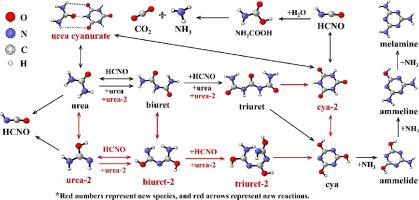Chemical Engineering Journal ( IF 13.3 ) Pub Date : 2023-06-20 , DOI: 10.1016/j.cej.2023.144176 Chong Xia , Yuanqing Zhu , Diantao Liu , Song Zhou , Yongming Feng , Jie Shi , Yang Jun

|
The problem of urea crystallization in selective catalytic reduction (SCR) systems has been a concern for a long time, especially in vehicle engine after-treatment. Compared with the vehicle engine SCR system, the layout space of the marine engine SCR system is more spacious, but the impingement of urea-water solution (UWS) on the wall as well as the formation of urea deposits still cannot be avoided in many cases. In this paper, the urea deposits in the SCR systems of 10 MW marine two-stroke and 140 kW marine four-stroke engines are taken as the research objects. The research results showed that the composition of urea deposits is affected by the composition of exhaust gas. Besides biuret, ammelide, cyanuric acid (cya) and its homologues, the urea deposits contain non-urea decomposition by-products such as particulate matter (PM) and sulfate. In addition, most of the existing urea decomposition mechanisms are obtained by inferring the intermediate reaction pathways through thermogravimetric analysis (TGA), which has the disadvantage of kinetic parameters being inaccurate calculation due to oversimplified reactions, and cannot explain the coexistence phenomenon of cya and its homologues in the urea deposits of marine SCR systems. Therefore, based on density functional theory (DFT), a new detailed urea decomposition mechanism is proposed in this paper, including 15 species and 23 reactions. This mechanism introduces homologues of urea, biuret, and triuret, complementing the reaction pathways for forming cya and its homologue, and is more reliable in theory. On this basis, the correctness of the proposed urea decomposition mechanism is validated by using the TGA experimental data of urea deposits and the urea decomposition kinetic model, and machine learning.
中文翻译:

新开发详细的船用发动机尿素分解机理-SCR系统结晶试验和DFT计算
选择性催化还原(SCR)系统中的尿素结晶问题长期以来一直受到人们的关注,特别是在车辆发动机后处理中。与车用发动机SCR系统相比,船用发动机SCR系统的布置空间更加宽敞,但很多情况下仍然无法避免尿素水溶液(UWS)对器壁的冲击以及尿素沉积物的形成。本文以10 MW船用二冲程和140 kW船用四冲程发动机SCR系统中的尿素沉积物为研究对象。研究结果表明,尿素沉积物的成分受废气成分的影响。除了缩二脲、三聚氰胺、氰尿酸(cya)及其同系物外,尿素沉积物还含有非尿素分解副产物,例如颗粒物(PM)和硫酸盐。此外,现有的尿素分解机理大多是通过热重分析(TGA)推断中间反应路径获得的,其缺点是反应过于简单化,导致动力学参数计算不准确,无法解释cya与其共存现象。海洋 SCR 系统尿素沉积物中的同系物。因此,基于密度泛函理论(DFT),本文提出了一种新的详细尿素分解机理,包括15个物种和23个反应。该机理引入了尿素、缩二脲、三缩脲的同系物,补充了形成cya及其同系物的反应途径,理论上更加可靠。以这个为基础,

































 京公网安备 11010802027423号
京公网安备 11010802027423号